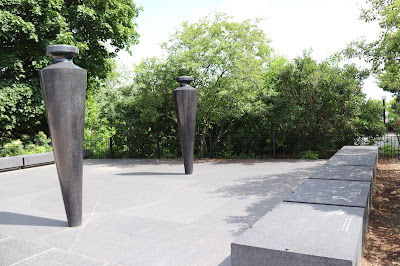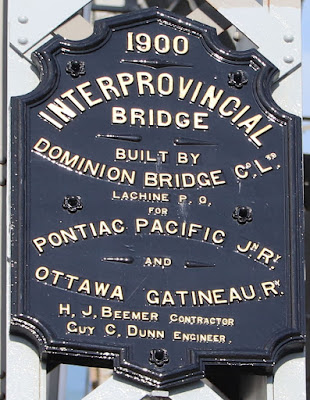The Canadian Building Trades Monument occupies a location in the northwest part of Major's Hill Park.
Canadian Building Trades Monument
This monument honours and celbrates the tradespeople who build and maintain Canada every day, and commemorates the losses they have endured in the workplace.
The sculptures represent tools known as plumb bobs. Used in construction since ancient times, they symbolize the intersection of earthly gravity and human ingenuity. The engraved tools depict the crafts of building trades unions, reminding us that basic tools, in the hands of skilled tradespeople, produce extraordinary results.
Realized by Canada's Building Trades Unions, affiliated unions and their employers, and unveiled on May 16, 2017, by the Right Honourable Justin P. J. Trudeau, PC, MP, Prime Minister of Canada
Standing Together
Architect: MacKay-Lyons Sweetapple Architects
Artist: John Greer
CBTU SMCC
Monument canadien des métiers de la construction
Ce monument célèbre et rend hommage aux gens de métier qui construisent et entretiennent le Canada chaque jour, et commémore les pertes qu'ils ont subies en accomplissant leur travail.
Les sculptures représentent des outils appelés fils à plomb. Utilises dans la construction depuis des temps immémoriaux, ils symbolisent le croisement entre la gravité terrestre et l'ingéniosité humaine. Les outils gravés sont emblematiques des syndicats de métiers de la construction, nous rappelant que des outils de base, dans les mains de gens de métier qualifiés, produisent de résultats extraordinaires.
Une initiative des Syndicats des métiers de la construction du Canada en pertenariat avec des syndicats affiliés et leurs employeurs, le monument a été dévoilé le 16 mai 2017, par le très honorable Justin P. J. Trudeau, C.P., député et premier ministre du Canada.
Solidaires
Architecte : MacKay-Lyons Sweetapple Architects
Artiste : John Greer
CBTU SMCC
Monday, March 30, 2020
Thursday, March 26, 2020
Hartin Hotel
The former Hartin Hotel, a designated heritage building occupies a location on the north side of Robertson Road just east of Old Richmond Road.
David Hartin (1824-1893) purchased the Malcomson Tavern on July 23, 1870. Later that year on August 17 the Great Fire of 1870 destroyed the building. Hartin had a larger stone building constructed on the site in 1871 and named it Hartin Hotel. The City of Ottawa designated this oldest building in Bells Corners a heritage building in 2014.
Ottawa c. 1871
Hartin Hotel
The Hartin Hotel is located on the site of a former tavern destroyed by the fire of 1870, at the junction of Old Richmond Road and Robertson Road, midway between Ottawa and Richmond. It was used as a stopping place for farmers and their horses, and played a part in the development of Bell's Corners. The building features a side gable roof and dressed limestone construction with decorative stone quoins and voussoirs.
Designated Heritage Property
Ottawa c. 1871
Hôtel Hartin
L'hôtel Hartin est situé sur le site d'une ancienne taverne qui a été détruite dans l'incendie de 1870, situé à la jonction du chemin Old Richmond et du chemin Robertson, entre Ottawa et Richmond. Il servait d'étape aux agriculteurs et à leurs chevaux, et il a joué un rôle dans l'essor de Bell's Corners. L'édifice arbore un toit à deux versants latéraux et un parement en calcaire façonné avec des chaines d'angle et des voussoirs décoratifs.
Désignée édifice patrimonial
David Hartin (1824-1893) purchased the Malcomson Tavern on July 23, 1870. Later that year on August 17 the Great Fire of 1870 destroyed the building. Hartin had a larger stone building constructed on the site in 1871 and named it Hartin Hotel. The City of Ottawa designated this oldest building in Bells Corners a heritage building in 2014.
Ottawa c. 1871
Hartin Hotel
The Hartin Hotel is located on the site of a former tavern destroyed by the fire of 1870, at the junction of Old Richmond Road and Robertson Road, midway between Ottawa and Richmond. It was used as a stopping place for farmers and their horses, and played a part in the development of Bell's Corners. The building features a side gable roof and dressed limestone construction with decorative stone quoins and voussoirs.
Designated Heritage Property
Ottawa c. 1871
Hôtel Hartin
L'hôtel Hartin est situé sur le site d'une ancienne taverne qui a été détruite dans l'incendie de 1870, situé à la jonction du chemin Old Richmond et du chemin Robertson, entre Ottawa et Richmond. Il servait d'étape aux agriculteurs et à leurs chevaux, et il a joué un rôle dans l'essor de Bell's Corners. L'édifice arbore un toit à deux versants latéraux et un parement en calcaire façonné avec des chaines d'angle et des voussoirs décoratifs.
Désignée édifice patrimonial
Monday, March 23, 2020
Alexandra Bridge
The Alexandra Bridge, a National Historic Civil Engineering Site, connects Ottawa and Gatineau across the Ottawa River, north of Parliament Hill and the Rideau Canal. It extends from Boulevard des Allumettières at Laurier Street in Gatineau to where Murray Street and St. Patrick Street join in Ottawa.
Alexandra Bridge
(Interprovincial)
This bridge was built by the Dominion Bridge Company of Lachine, Quebec, and H.J. Beemer, contractor, for teh Pontiac Pacific Junction Railway and the Ottawa Gatineau Railway. Construction began in February, 1898; the bridge was opened to the public in March, 1901.
Pont Alexandra
(Interprovincial)
Ce pont a été contruit par la «Dominion Bridge Company» de Lachine, Québec et par l'entrepreneur H.J. Beemer, pour les compagnies de chemin de fer «Pontiac Pacific Junction» et «Ottawa Gatineu». La construction du pont a débuté en février 1898 et ce dernier a été ouvert au public en mars 1901.
NATIONAL HISTORIC
CIVIL ENGINEERING
SITE
ALEXANDRA (INTERPROVINCIAL) BRIDGE
Constructed using the most advanced technologies available at the time, the Alexandra Bridge stands today as evidence of the outstanding ingenuity and foresight of Canadian engineers.
G. Dunn, Chief Railway Engineer
H.J. Beemer, General Contractor
C.H. Deans, Contractor (piers)
Dominion Bridge Company (superstructure)
Start of construction: February 1898
Inauguration: March 1901
Commemoration: June 1995
CANADIAN SOCIETY FOR CIVIL ENGINEERING
SITE HISTORIQUE
NATIONAL
DE GÉNIE CIVIL
PONT ALEXANDRA (INTERPROVINCIAL)
Construit selon les techniques les plus avancées de l'epoque, le pont Alexandra témoigne aujourd'hui de l'ingéniosité et de la prévoyance remarquables de ingénieurs canadiens.
G. Dunn, ingénieur en chef des chemins de fer
H.J. Beemer, entrepreneur général
C.H. Deans, entrepreneur (piliers)
Dominion Bridge Company (superstructure)
Début de la construction : février 1898
Inauguration : mars 1901
Commémoration : juin 1995
SOCIÉTÉ CANADIENNE DE GÉNIE CIVIL
Pont Alexandra
(Interprovincial)
Ce pont a été contruit par la «Dominion Bridge Company» de Lachine, Québec et par l'entrepreneur H.J. Beemer, pour les compagnies de chemin de fer «Pontiac Pacific Junction» et «Ottawa Gatineu». La construction du pont a débuté en février 1898 et ce dernier a été ouvert au public en mars 1901.
Alexandra Bridge
(Interprovincial)
This bridge was built by the Dominion Bridge Company of Lachine, Quebec, and H.J. Beemer, contractor, for teh Pontiac Pacific Junction Railway and the Ottawa Gatineau Railway. Construction began in February, 1898; the bridge was opened to the public in March, 1901.
SITE HISTORIQUE
NATIONAL
DE GÉNIE CIVIL
PONT ALEXANDRA (INTERPROVINCIAL)
Construit selon les techniques les plus avancées de l'epoque, le pont Alexandra témoigne aujourd'hui de l'ingéniosité et de la prévoyance remarquables de ingénieurs canadiens.
G. Dunn, ingénieur en chef des chemins de fer
H.J. Beemer, entrepreneur général
C.H. Deans, entrepreneur (piliers)
Dominion Bridge Company (superstructure)
Début de la construction : février 1898
Inauguration : mars 1901
Commémoration : juin 1995
SOCIÉTÉ CANADIENNE DE GÉNIE CIVIL
NATIONAL HISTORIC
CIVIL ENGINEERING
SITE
ALEXANDRA (INTERPROVINCIAL) BRIDGE
Constructed using the most advanced technologies available at the time, the Alexandra Bridge stands today as evidence of the outstanding ingenuity and foresight of Canadian engineers.
G. Dunn, Chief Railway Engineer
H.J. Beemer, General Contractor
C.H. Deans, Contractor (piers)
Dominion Bridge Company (superstructure)
Start of construction: February 1898
Inauguration: March 1901
Commemoration: June 1995
CANADIAN SOCIETY FOR CIVIL ENGINEERING
(Interprovincial)
This bridge was built by the Dominion Bridge Company of Lachine, Quebec, and H.J. Beemer, contractor, for teh Pontiac Pacific Junction Railway and the Ottawa Gatineau Railway. Construction began in February, 1898; the bridge was opened to the public in March, 1901.
(Interprovincial)
Ce pont a été contruit par la «Dominion Bridge Company» de Lachine, Québec et par l'entrepreneur H.J. Beemer, pour les compagnies de chemin de fer «Pontiac Pacific Junction» et «Ottawa Gatineu». La construction du pont a débuté en février 1898 et ce dernier a été ouvert au public en mars 1901.
CIVIL ENGINEERING
SITE
ALEXANDRA (INTERPROVINCIAL) BRIDGE
Constructed using the most advanced technologies available at the time, the Alexandra Bridge stands today as evidence of the outstanding ingenuity and foresight of Canadian engineers.
H.J. Beemer, General Contractor
C.H. Deans, Contractor (piers)
Dominion Bridge Company (superstructure)
Start of construction: February 1898
Inauguration: March 1901
Commemoration: June 1995
CANADIAN SOCIETY FOR CIVIL ENGINEERING
NATIONAL
DE GÉNIE CIVIL
PONT ALEXANDRA (INTERPROVINCIAL)
Construit selon les techniques les plus avancées de l'epoque, le pont Alexandra témoigne aujourd'hui de l'ingéniosité et de la prévoyance remarquables de ingénieurs canadiens.
H.J. Beemer, entrepreneur général
C.H. Deans, entrepreneur (piliers)
Dominion Bridge Company (superstructure)
Début de la construction : février 1898
Inauguration : mars 1901
Commémoration : juin 1995
SOCIÉTÉ CANADIENNE DE GÉNIE CIVIL
(Interprovincial)
Ce pont a été contruit par la «Dominion Bridge Company» de Lachine, Québec et par l'entrepreneur H.J. Beemer, pour les compagnies de chemin de fer «Pontiac Pacific Junction» et «Ottawa Gatineu». La construction du pont a débuté en février 1898 et ce dernier a été ouvert au public en mars 1901.
(Interprovincial)
This bridge was built by the Dominion Bridge Company of Lachine, Quebec, and H.J. Beemer, contractor, for teh Pontiac Pacific Junction Railway and the Ottawa Gatineau Railway. Construction began in February, 1898; the bridge was opened to the public in March, 1901.
NATIONAL
DE GÉNIE CIVIL
PONT ALEXANDRA (INTERPROVINCIAL)
Construit selon les techniques les plus avancées de l'epoque, le pont Alexandra témoigne aujourd'hui de l'ingéniosité et de la prévoyance remarquables de ingénieurs canadiens.
G. Dunn, ingénieur en chef des chemins de fer
H.J. Beemer, entrepreneur général
C.H. Deans, entrepreneur (piliers)
Dominion Bridge Company (superstructure)
Début de la construction : février 1898
Inauguration : mars 1901
Commémoration : juin 1995
SOCIÉTÉ CANADIENNE DE GÉNIE CIVIL
CIVIL ENGINEERING
SITE
ALEXANDRA (INTERPROVINCIAL) BRIDGE
Constructed using the most advanced technologies available at the time, the Alexandra Bridge stands today as evidence of the outstanding ingenuity and foresight of Canadian engineers.
G. Dunn, Chief Railway Engineer
H.J. Beemer, General Contractor
C.H. Deans, Contractor (piers)
Dominion Bridge Company (superstructure)
Start of construction: February 1898
Inauguration: March 1901
Commemoration: June 1995
CANADIAN SOCIETY FOR CIVIL ENGINEERING
Subscribe to:
Posts (Atom)






















































































